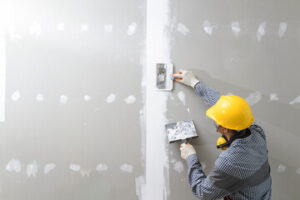Drywall Repair can seem intimidating, but homeowners can perform some basic repairs. There are a few things to keep in mind before starting. First, consider the size of the hole. Larger holes require a more extensive patching process. Next, consider the cause of the damage. Leaking water damage can wreak havoc on drywall and should be addressed before any repairs are made. To learn more, visit Drywall Repair Las Vegas.
 One of the most common drywall repair issues involves holes. While fixing small dents and scratches in drywall is fairly easy, larger holes require a more involved process. Whether you’re dealing with a hole in your home’s wall or ceiling, you can cover it up with a spackle or use a drywall patch to create a more substantial repair.
One of the most common drywall repair issues involves holes. While fixing small dents and scratches in drywall is fairly easy, larger holes require a more involved process. Whether you’re dealing with a hole in your home’s wall or ceiling, you can cover it up with a spackle or use a drywall patch to create a more substantial repair.
Before fixing a hole in your drywall, ensure you have the right materials and tools. A stud finder can help you locate the studs on both sides of the damage so you don’t accidentally cut into them. A carpenter’s square can also outline the area you’ll be cutting, making it easier to keep your lines straight.
If you’re working with a large hole, the first step is to lay down some self-adhering mesh patching material. This will add strength to the drywall patch and prevent future cracking of your repaired wall or ceiling. Once the patching material is in place, apply a thin layer of drywall compound over it, using a putty knife specifically designed for drywall repair. Smooth the compound until it’s flat with the rest of the surface and allow it to dry for 24 hours.
The next step is to screw the drywall patch into the studs with drywall screws every 6 inches. It’s a good idea to install the screws at an angle so that they sit flush with the patch and don’t cause a ridge. You can then sand the patch and compound until it is smooth to the touch, which will make it easier to paint once again.
If you need to, you can reapply another layer of compound and repeat the mudding and sanding until the patch is completely smooth and ready for painting again. Don’t forget to choose a high-quality drywall primer and paint once the patch is fully dry to ensure it lasts as long as possible. If you’re not comfortable taking on a project like this yourself, you can hire a local drywall contractor to fix the damage for you.
Repairing Cracks
While some cracks in drywall are nothing to worry about, others are a sign of serious problems and should not be ignored. Cracks that widen and run across one or more wall studs or are discolored should be evaluated by a professional, as they could indicate a structural issue such as a sagging ceiling or a leak that needs to be repaired. While fixing these more significant cracks requires a bit of extra time and effort, it is much less costly than ignoring the problem until it becomes more serious.
Hairline cracks that appear above and below windows and doors are often caused by lumber shrinkage or settling in the house frame. The solution is to use a putty knife to apply a skim coat of joint compound over the crack, using a light touch so that it is not noticeable. This should be sanded smooth and then painted. If the crack reappears, repeat this process.
If the cracks are wider than a quarter inch or have dark brown stains around them, they are most likely from water damage and will require more extensive repairs than just filling the cracks. This can include repairing the underlying wood and retaping the joints. It is also important to find and fix the source of the moisture, whether it is a leaking window or roof, or even a plumbing leak.
It is possible to repair cracks in drywall without the help of a professional, but it is always best to hire one to do the job right. An experienced drywall repairman will know the best methods to use and can ensure that the results of the drywall repair are satisfactory, especially when it comes time to repaint the area.
When attempting to repair cracked drywall, make sure that the surface is free of any paint or other debris that may be stuck to it. If the cracks are not repaired properly, they can reappear and become more serious over time. In addition, when trying to repair cracks in drywall, it is best to do only a few at a time and to allow the new compound to dry completely between applications.
Repairing Mold or Moisture Issues
Drywall repair projects often involve removing and replacing drywall that has been affected by mold or moisture. Moisture can damage drywall, causing discoloration, staining, and odor. It can also cause the drywall to bow, sag, or crumble. It is important to address the source of the problem before you attempt any drywall repair or replacement.
Mold on drywall usually looks like dark stains or patches. It is most commonly found in areas that experience high levels of humidity or that are poorly ventilated such as bathrooms and basements. It is also common for mold to appear after a flood or water damage.
If you suspect that there is mold in the walls of your home, it’s best to consult a professional for mold remediation services. Mold is a serious health issue and can be dangerous for young children, elderly people, or those with allergies. If you are selling your home, potential buyers may ask that you remediate any mold before they buy it.
Before you begin working on a drywall repair project that involves mold, make sure to protect yourself and the area by wearing protective gear such as a mask, eye protection, and gloves. You should also cover the floor with plastic sheeting and seal off doors to prevent the spread of mold spores throughout your home.
Begin by shutting off power to the area of the wall with mold at the electric service panel. Then mark off the area with a pencil or painter’s tape. Use a stud finder to locate the positions of the wall studs in the area. Then, using a utility knife, cut along the marked line. Remove the moldy drywall and place it into large contractor bags. Once you have removed the moldy drywall, you should check behind it to see if it has spread to the studs or other parts of the wall.
Once you have removed the drywall, spray the area with a mold control product to kill any spores that may be present. If you are concerned about mold, consider testing the air quality before proceeding with any drywall repairs. There are inexpensive test kits that can determine if the mold is toxic or not.
Repairing Nail Pops
Nail pops are those unsightly circles that speckle your walls and ceiling. They are caused by nails and screws that have worked their way loose over time. These nail or screw protrusions are cosmetic in nature and don’t affect your home’s structure, but they do need to be repaired to maintain a smooth wall surface.
It is very important to secure these loose drywall fasteners to prevent them from popping out again. This is especially true if the popped nails appear in an area where there are other signs of foundation issues, such as doors that are hard to close or cracks in your drywall. These other signs should be investigated by a contractor and possibly by a structural engineer to determine whether the foundation of your home is shifting more than it should.
To repair a nail pop, first remove any bits of drywall compound or built-up paint that are surrounding the hole. Then, use the blade of your putty knife to scrape away any lingering chunks of drywall that may be on the surface of the nail or screw hole. This will help ensure the new drywall patch will adhere to the wall.
Next, locate the studs that are supporting the damaged section of wallboard. This is usually easy, as most utilities, including your home’s electrical wiring and plumbing, run along the studs in your home’s wall. Tap on the drywall where you have located the framing. You should hear a hollow sound if there is no framing behind the wallboard. If this is the case, drive a screw through the drywall and into the framing an inch or two above and below the nail pop to re-secure the drywall to the framing.
Now, apply a coat of joint compound to the nail or screw holes. Allow this coat to dry completely before applying a second coat, and then sand the area using your drywall sanding sponge until it is smooth. Now, you can prime and paint the repaired area to restore a smooth surface in this section of your wall or ceiling.
